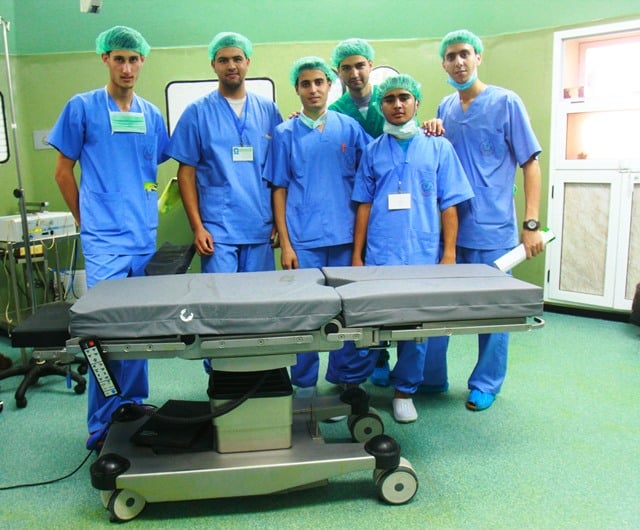
Photo: PalMed, courtesy von Bartha Gallery.
Casualties of recent fighting in the Gaza Strip may well find themselves undergoing surgery atop an operating table that is also an artwork. In what the three-man Danish collective Superflex calls a “readymade upside-down,” the artists organized for a museum exhibition of top-of-the-line medical equipment which then went to a setting defined less by well-heeled visitors than by life-threatening injuries.
As a result, Al-Shifa Hospital is the beneficiary of some $90,000 worth of goods, including the operating table and surgical lamps, with the financial support of Danish product design company Area9, which is one of three private collectors to acquire the piece. The table itself, the motorized, highly mobile Trumpf Medical MARS model, represented more than half the cost. The choice of equipment was guided by by PalMed, an organization of medical professionals who aim to provide improved care for Palestinians living in Gaza. Al-Shifa treated the largest number of victims of the most recent conflict in Gaza, says Dr. Mahmoud Ismail, head of PalMed’s Danish office, in a press release.
Working together since 1993, the artists (Bjørnstjerne Christiansen, Jakob Fenger, and Rasmus Nielsen) have created socially-engaged projects in various mediums that examine the baleful effects of capitalism via financial and banking structures, the place of fossil fuel in the global economy, and systems of free trade, among other subjects.
They’ve often used the toilet, the form of Marcel Duchamp’s first readymade, in their acid commentary on structures of power. The trio installed a replica of the executive bathrooms at JP Morgan Chase in the low-rent Olympic Restaurant on New York’s Lower East Side in 2011 as part of Creative Time’s show “Living as Form,” and duplicated United Nations Security Council bathrooms in a beachfront park in the Netherlands.
The artists got an ironic bit of wider exposure following Superstorm Sandy, in 2012. Their 2009 video Flooded McDonalds, showing an inundated burger joint, was intended as a jab at multinational corporations’ powerlessness in the face of global warming; many people mistook stills for actual footage when they circulated online after Sandy ravaged the US East Coast.
They’ve also engaged with the Palestine issue and wider Middle East conflicts before. In Palestinian Eurovision (2008), they lobbied for the Palestinian Broadcasting Corporation to get membership in the European Broadcasting Union, which would allow it to participate in the wildly popular Eurovision song contest. And two years after the US invasion of Iraq, in response to a 2005 invitation from the National Gallery of Denmark, the artists proposed to fill up a truck with Iraqi oil and park it in front of the institution. On receiving the proposal, the museum administration promptly cut off all communication, say the artists.
Superflex’s 2014-15 exhibition “Hospital Equipment,” at the Den Frie Center for Contemporary Art.
Photo: Anders Sune Berg, courtesy Superflex.
The first stop for “Hospital Equipment” was the Den Frie Center for Contemporary Art, in Copenhagen, where it was on view at the end of 2014. The operating table stood at the center of a white-cube gallery, while surgical lamps hung suspended from the ceiling above.
“We tried to establish a one-to-one relationship with how it would appear in the hospital,” Christiansen said in a phone interview from Paris, where Superflex has been commissioned to do artworks in the subway system.
The table itself is outfitted with articulated sections for each arm and each leg, Christiansen pointed out, which lent it some resemblance to an actual human figure lying on its back in the gallery. This gave it a particular emotional power, he said. Some people cried on seeing the objects, Christiansen reported, while others couldn’t even bring themselves to look at them.
“You don’t need to show a dead person on a beach to make people transport themselves to a situation where you’re dealing with life and death,” he said, referring to Syrian toddler Aylan Kurdi, who made international headlines in 2015, after he and other members of his family drowned while trying to reach Europe.
Another Superflex work, currently on view in Morocco, ties the Middle East refugee crisis to Western myth. The Marrakech Biennial, “Not New Now” (through May 8), includes their video Kwassa Kwassa, which focuses on craftsmen on the island of Anjouan, in the Comoro Islands, who build fiberglass boats used to transport migrants and refugees. The voiceover calls the mythical Phoenician figure of Europa, seduced and carried away to Crete by Zeus in the form of a white bull, the original Arabic refugee; Zeus, it says, is the first smuggler.
Getting the hospital equipment to Gaza presented a challenge, since the Israeli Crossing Points Authority is responsible for inspecting incoming goods. The artists have friends who work for the World Health Organization, whose support was essential. Without them, Christiansen said, “We could very well have risked the equipment ending up in storage in Israel indefinitely.”
The project takes place against the backdrop of a soaring art market where paintings and sculptures by artists like Pablo Picasso, Paul Gauguin, and Alberto Giacometti trade hands for amounts north of $100 million at auction. These transactions, by contrast to Superflex’s project, primarily see objects going from one private home or storage vault to another.
In that context, the artists think of the project partly as a comment on the fetishizing of the art object.
“We want to challenge collecting itself,” Christiansen said. “Do you have to have the object, or can it be just as valuable to you that it be activated somewhere else?”